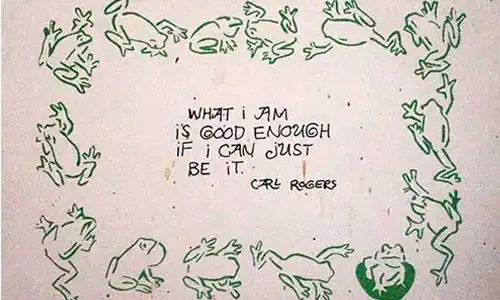THE PSYCHOTHERAPY OF CARL ROGERS:
GOOD ENOUGH
BY WILL STILLWELL
GOOD ENOUGH

In a learning quest for truth, all results are positive steps toward the goal, even if one’s expectations are disappointed.
Rogers says, “the facts are friendly.”
Rogers trusts his life-world. “What I am and what I feel are good enough to be a basis for therapy, if…in relation to…the client…I can transparently be what I am and what I feel.”
One’s healthy self has to be, and feel, good-enough to meet living’s realities, including one’s own inner world.
Rogers activates “the space between” himself and the other learning person toward “living together in communication that breaks [individual] isolation.”
He chooses to be “a companion you can trust” for the other. And his experience has taught him that other people too at their core are good enough, are and constructive and companions worthy of his (and our) trust.
My self-regard – my relationships among my multitudinous sense of self – is one destination of this psychotherapy. My self-regard is kneaded in the nexus of my meetings with other people where in my past I’ve learned how and what to experience. And of equal importance, I have created much of my self-concept from the touches with others from which I take rewards and punishments. Rogers’ presence with me – his authentic non-oppositional relating in attraction and attachment – has grown from his wholeness of congenial relations within himself and his nurtured, consentient abilities to accept my validity of experiences and self-authority. I am eased into a fresh learning environment-relationship. “The strongest factor for making change that I know is accepting the person as he is,” Rogers says, and I believe he feels his limiting, valuing requirements are irrelevant and even harmful here.
Holding this positive abiding as an assumption, one might say a conviction (or a “philosophy”) – allows Rogers a powerful entry into his encounters with others. Trustworthy companionship eases all participants in establishing self-generated trust and constructive creation. His “interventions” – if his comments can even be considered to fit terminology appropriate to other kinds of psychotherapy – are a manifestation of a positive presence.
Even though the internal world of a companion may be full of troublesome self-judging oppositions, Rogers can approach the person with warm acceptance. Irrelevant, even counterproductive and obstructive would be any of Rogers’ disagreements with the client’s views, or Rogers’ evaluative, good/bad judgments about the other. This does not deny that he considers psychotherapy a moral encounter, only that here moral concerns do not have automatic or doctrinal answers.
Rogers encounters the separate self of a client across the trusting space between. Same and different – self and other – each is continually born anew from experience-made-public.
The relationship grows as the client shifts from attending to the contrasts between her own internal divisions to noticing contrasts that identify the separate entities of herself and her therapist. In order to meet Rogers in relationship, the client’s internal divisions are called to coalesce: the client starkly beholds her process as she is choosing to divide herself internally. She realizes that “My own resistance stops me from feeling good enough to face and communicate my problems to Carl Rogers.”

Mistakes yes, Rogers miss-takes where the clients’ feelings are journeying, where the client chooses to go. Here, Rogers in his response extends to Richie a sense of two possible divisions of Richie’s internal self.
Richie’s reply shows that his own thoughts now go toward the division between himself and other people rather than within himself. After his own brief confusion, Rogers follows that.
Who has mis-understood whom here? If Rogers has misunderstood Ritchie, Rogers’ personal creative and theoretical biases are exposed. But to Rogers this is unimportant – what is important is that his personal bias not be imposed upon Ritchie. We are good-enough as we keep open, learning and improving from the mis-takes.

In a film demonstrating his therapy made in the 1950's, Rogers comments, “In some sense the most you can give: be willing to go with them in their own separate feelings as a separate person…let him or her possess his own feelings”
If the therapist permits and does not interfere in her learning process, the client will discover and choose her self, her life-world. A person comes to her own self-approval (or not), she is responsible for her own “good-enough.” “The more I’m open to the realities of life, the less likely I am to rush in.”
